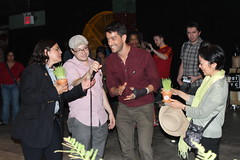Photos: Alexa Mae Asperin
On Saturday, City Council members Rosie Mendez and Margaret Chin threw their weight behind a plan to build a public park beneath Delancey Street, imploring local residents to demand that Governor Cuomo make the buzzy Lowline a reality.
“We need your help,” Ms. Chin told dozens gathered at “Imagining the Lowline,” a new exhibit that offers a glimpse of the project’s potential future. “You have to help us get to other elected officials, like our governor.”
The council members envision the Lowline as a place for children, seniors and lifelong East Village and Lower East Siders to enjoy. “We don’t have that much green space, so it’s much needed down here,” Ms. Chin told The Local, noting that public housing residents often have to “walk quite a long way” for recreation.
Since first publicizing the Delancey Underground, or Lowline, last September, its creators, James Ramsey and Dan Barasch, have pitched it to schoolchildren, organized street fairs with local businesses, and visited neighborhood bars. “Imagining the Lowline” is their latest effort to garner support. In a warehouse at the Essex Street Market, the windows and skylights have been blacked out to mimic the proposed site of the subterranean park. Yesterday, the crowd gathered around an eight-foot-tall Japanese maple tree housed under a canopy of reflective domes.
If adopted, the Lowline project would bring that kind of greenery and innovative technology to the former Williamsburg Trolley Terminal, a 60,000-square-foot space (about the size of Gramercy Park) running beneath Delancey Street. Vacant since 1948, the former streetcar terminal is owned by the MTA and still boasts incredible “remnant cobblestones, crisscrossing rail tracks and vaulted ceilings,” according to the designers’ Website.
The underground station was built and abandoned before the MTA existed. The transportation authority inherited the space, explained Mr. Barasch, who is hoping the agency will let him and his partner develop it.
“It is all an effort to get more grassroots support for the idea, so we can take it to the city and the governor and say, ‘Listen, this is a really community-supported idea and a project that should move ahead,'” Mr. Barasch said.
Ms. Chin believes Governor Cuomo’s involvement would help make that happen. “I think we need our governor, so the MTA can hand over the site so we can create something wonderful in our district,” she said.
Mr. Barasch said there was precedent for such an arrangement. “This site, in theory, is in the same real estate portfolio as places the MTA has been able to sell or rent out, like the mausoleum in Grand Central that’s now an Apple Store,” he said. “Our hope is to transfer access of this site to the city and essentially work directly with the city to build it out.”
The Lower East Side has a strong history of reinventing space, Ms. Mendez reminded the crowd. She noted that residents have turned crumbling buildings into homes and dilapidated space into community gardens. “This just goes to the history of our community and redemptive uses, creativity and preservation,” she said.
For now, it’s all about awareness and garnering support, said Mr. Barasch. Since the exhibit opened Sept. 15, he and Mr. Ramsey have welcomed several local public schools, the Lower Eastside Girls Club and neighborhood businesses into the exhibition space, which also serves as a testing grounds. On Saturday, the exhibit hosted Lost Weekend, a coffee shop and gallery on Orchard Street. It was such a hit with visitors that at one point, the baristas ran out of hot water.
“Imagining the Lowline” is open to the public until Sept. 27.




